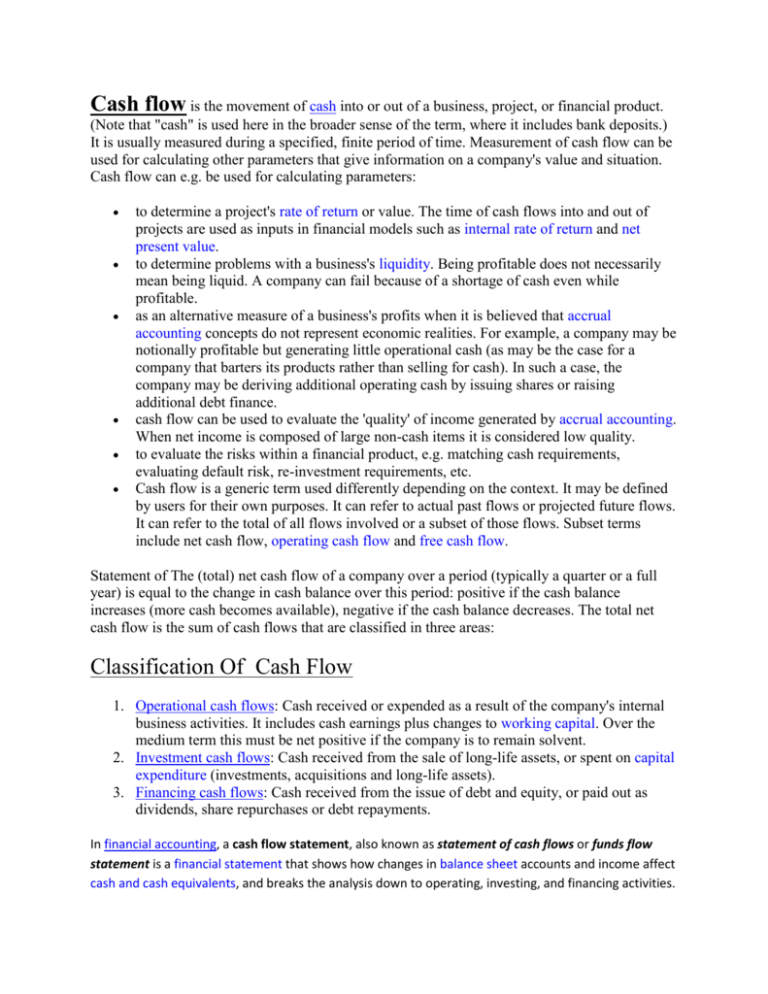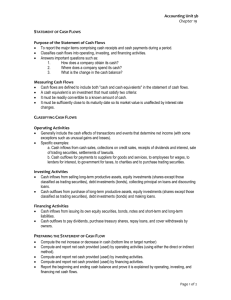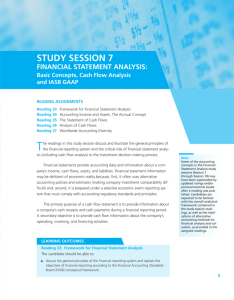Cash flow activities
advertisement

Cash flow is the movement of cash into or out of a business, project, or financial product. (Note that "cash" is used here in the broader sense of the term, where it includes bank deposits.) It is usually measured during a specified, finite period of time. Measurement of cash flow can be used for calculating other parameters that give information on a company's value and situation. Cash flow can e.g. be used for calculating parameters: to determine a project's rate of return or value. The time of cash flows into and out of projects are used as inputs in financial models such as internal rate of return and net present value. to determine problems with a business's liquidity. Being profitable does not necessarily mean being liquid. A company can fail because of a shortage of cash even while profitable. as an alternative measure of a business's profits when it is believed that accrual accounting concepts do not represent economic realities. For example, a company may be notionally profitable but generating little operational cash (as may be the case for a company that barters its products rather than selling for cash). In such a case, the company may be deriving additional operating cash by issuing shares or raising additional debt finance. cash flow can be used to evaluate the 'quality' of income generated by accrual accounting. When net income is composed of large non-cash items it is considered low quality. to evaluate the risks within a financial product, e.g. matching cash requirements, evaluating default risk, re-investment requirements, etc. Cash flow is a generic term used differently depending on the context. It may be defined by users for their own purposes. It can refer to actual past flows or projected future flows. It can refer to the total of all flows involved or a subset of those flows. Subset terms include net cash flow, operating cash flow and free cash flow. Statement of The (total) net cash flow of a company over a period (typically a quarter or a full year) is equal to the change in cash balance over this period: positive if the cash balance increases (more cash becomes available), negative if the cash balance decreases. The total net cash flow is the sum of cash flows that are classified in three areas: Classification Of Cash Flow 1. Operational cash flows: Cash received or expended as a result of the company's internal business activities. It includes cash earnings plus changes to working capital. Over the medium term this must be net positive if the company is to remain solvent. 2. Investment cash flows: Cash received from the sale of long-life assets, or spent on capital expenditure (investments, acquisitions and long-life assets). 3. Financing cash flows: Cash received from the issue of debt and equity, or paid out as dividends, share repurchases or debt repayments. In financial accounting, a cash flow statement, also known as statement of cash flows or funds flow statement is a financial statement that shows how changes in balance sheet accounts and income affect cash and cash equivalents, and breaks the analysis down to operating, investing, and financing activities. Essentially, the cash flow statement is concerned with the flow of cash in and cash out of the business. The statement captures both the current operating results and the accompanying changes in the balance sheet.[1] As an analytical tool, the statement of cash flows is useful in determining the shortterm viability of a company, particularly its ability to pay bills. International Accounting Standard 7 (IAS 7), is the International Accounting Standard that deals with cash flow statements. People and groups interested in cash flow statements include: Accounting personnel, who need to know whether the organization will be able to cover payroll and other immediate expenses Potential lenders or creditors, who want a clear picture of a company's ability to repay Potential investors, who need to judge whether the company is financially sound Potential employees or contractors, who need to know whether the company will be able to afford compensation Shareholders of the business. PURPOSE The cash flow statement was previously known as the flow of Cash statement. The cash flow statement reflects a firm's liquidity.The balance sheet is a snapshot of a firm's financial resources and obligations at a single point in time, and the income statement summarizes a firm's financial transactions over an interval of time. These two financial statements reflect the accrual basis accounting used by firms to match revenues with the expenses associated with generating those revenues. The cash flow statement includes only inflows and outflows of cash and cash equivalents; it excludes transactions that do not directly affect cash receipts and payments. These non-cash transactions include depreciation or write-offs on bad debts or credit losses to name a few. The cash flow statement is a cash basis report on three types of financial activities: operating activities, investing activities, and financing activities. Non-cash activities are usually reported in footnotes. 1. The cash flow statement is intended to 2. provide information on a firm's liquidity and solvency and its ability to change cash flows in future circumstances 3. provide additional information for evaluating changes in assets, liabilities and equity 4. improve the comparability of different firms' operating performance by eliminating the effects of different accounting methods 5. indicate the amount, timing and probability of future cash flows The cash flow statement has been adopted as a standard financial statement because it eliminates allocations, which might be derived from different accounting methods, such as various timeframes for depreciating fixed assets History & variations Cash basis financial statements were very common before accrual basis financial statements. The "flow of funds" statements of the past were cash flow statements. In 1863, the Dowlais Iron Company had recovered from a business slump, but had no cash to invest for a new blast furnace, despite having made a profit. To explain why there were no funds to invest, the manager made a new financial statement that was called a comparison balance sheet, which showed that the company was holding too much inventory. This new financial statement was the genesis of Cash Flow Statement that is used today.[ In the United States in 1971, the Financial Accounting Standards Board (FASB) defined rules that made it mandatory under Generally Accepted Accounting Principles (US GAAP) to report sources and uses of funds, but the definition of "funds" was not clear."Net working capital" might be cash or might be the difference between current assets and current liabilities. From the late 1970 to the mid-1980s, the FASB discussed the usefulness of predicting future cash flows. In 1987, FASB Statement No. 95 (FAS 95) mandated that firms provide cash flow statements. In 1992, the International Accounting Standards Board issued International Accounting Standard 7 (IAS 7), Cash Flow Statements, which became effective in 1994, mandating that firms provide cash flow statements. US GAAP and IAS 7 rules for cash flow statements are similar, but some of the differences are: IAS 7 requires that the cash flow statement include changes in both cash and cash equivalents. US GAAP permits using cash alone or cash and cash equivalents IAS 7 permits bank borrowings (overdraft) in certain countries to be included in cash equivalents rather than being considered a part of financing activities. IAS 7 allows interest paid to be included in operating activities or financing activities. US GAAP requires that interest paid be included in operating activities. US GAAP (FAS 95) requires that when the direct method is used to present the operating activities of the cash flow statement, a supplemental schedule must also present a cash flow statement using the indirect method. The IASC strongly recommends the direct method but allows either method. The IASC considers the indirect method less clear to users of financial statements. Cash flow statements are most commonly prepared using the indirect method, which is not especially useful in projecting future cash flows. Cash flow activities The cash flow statement is partitioned into three segments, namely: 1) cash flow resulting from operating activities; 2) cash flow resulting from investing activities; 3)cash flow resulting from financing activities. Cash inflow The money coming into the business is called cash inflow, Cash outflow The money going out from the business is called cash outflow. Operating activities Operating activities include the production, sales and delivery of the company's product as well as collecting payment from its customers. This could include purchasing raw materials, building inventory, advertising, and shipping the product. Under IAS 7, operating cash flows include: Receipts from the sale of goods or services Receipts for the sale of loans, debt or equity instruments in a trading portfolio Interest received on loans Dividends received on equity securities Payments to suppliers for goods and services Payments to employees or on behalf of employees Interest payments (alternatively, this can be reported under financing activities in IAS 7, and US GAAP) Items which are added back to [or subtracted from, as appropriate] the net income figure (which is found on the Income Statement) to arrive at cash flows from operations generally include: Depreciation (loss of tangible asset value over time) Deferred tax Amortization (loss of intangible asset value over time) Any gains or losses associated with the sale of a non-current asset, because associated cash flows do not belong in the operating section.(unrealized gains/losses are also added back from the income statement) Investing activities Examples of Investing activities are Purchase or Sale of an asset (assets can be land, building, equipment, marketable securities, etc.) Loans made to suppliers or received from customers Payments related to mergers and acquisitions Financing activities Financing activities include the inflow of cash from investors such as banks and shareholders, as well as the outflow of cash to shareholders as dividends as the company generates income. Other activities which impact the long-term liabilities and equity of the company are also listed in the financing activities section of the cash flow statement. Under IAS 7, Proceeds from issuing short-term or long-term debt Payments of dividends Payments for repurchase of company shares Repayment of debt principal, including capital leases For non-profit organizations, receipts of donor-restricted cash that is limited to long-term purposes Items under the financing activities section include: Dividends paid Sale or repurchase of the company's stock Net borrowings Payment of dividend The direct method for creating a cash flow statement reports major classes of gross cash receipts and payments. Under IAS 7, dividends received may be reported under operating activities or under investing activities. If taxes paid are directly linked to operating activities, they are reported under operating activities; if the taxes are directly linked to investing activities or financing activities, they are reported under investing or financing activities. [Indirect method The indirect method uses net-income as a starting point, makes adjustments for all transactions for non-cash items, then adjusts from all cash-based transactions. An increase in an asset account is subtracted for net income, and an increase in a liability account is added back to net income. This method converts accrual-basis net income (or loss) into cash flow by using a series of additions and deductions.[14] [Rules (Operating Activities) The following rules can be followed to calculate Cash Flows from Operating Activities when given only a two year comparative balance sheet and the Net Income figure. Cash Flows from Operating Activities can be found by adjusting Net Income relative to the change in beginning and ending balances of Current Assets, Current Liabilities, and sometimes Long Term Assets. When comparing the change in long term assets over a year, the accountant must be certain that these changes were caused entirely by their devaluation rather than purchases or sales (ie they must be operating items not providing or using cash) or if they are nonoperating items Rules (Financing Activities) Finding the Cash Flows from Financing Activities is much more intuitive and needs little explanation. Generally, the things to account for are financing activities: Include as outflows, reductions of long term notes payable (as would represent the cash repayment of debt on the balance sheet) Or as inflows, the issuance of new notes payable Include as outflows, all dividends paid by the entity to outside parties Or as inflows, dividend payments received from outside parties Include as outflows, the purchase of notes stocks or bonds Or as inflows, the receipt of payments on such financing vehicles.[citation needed] In the case of more advanced accounting situations, such as when dealing with subsidiaries, the accountant must.... Special:Search





